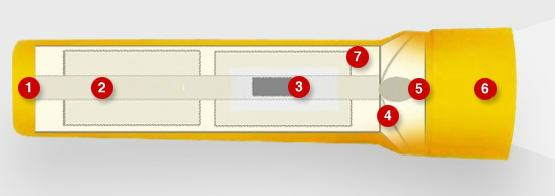1 Answer
How Do Flashlights Work?

1 - Case The tube that houses the parts of the flashlight, including the batteries and lamp (light bulb).
2 - Contacts A very thin spring or strip of metal (usually copper or brass) that is located throughout the flashlight, making the electrical connection between the various parts – the batteries, the lamp, and the switch. These parts conduct electricity and "hook everything up," completing the circuit.
3 - Switch The flow of the electricity is activated when you push the switch into the ON position, giving you light. The flow of electricity is broken when the switch is pushed into the OFF position, thus turning off the light.
4 - Reflector A plastic part, coated with a shiny aluminum layer that rests around the lamp (light bulb) and redirects the light rays from the lamp to allow a steady light beam, which is the light you see emitting from the flashlight.
5 - Lamp The light source in a flashlight. In most flashlights, the lamp is either a tungsten filament (incandescent bulb) or a light emitting diode (solid state bulb), also known as an LED. The tungsten filament or LED glows when electricity flows through it, thus producing visible light. Tungsten is a natural element and the tungsten filament is a very thin wire. Tungsten lamps must be replaces when the tungsten filament breaks. An LED contains a very small semiconductor (diode) that is encapsulated in epoxy and this part emits light when electricity flows through it. LED's om flashlights are widely considered "unbreakable" and not replaced – a lifetime lamp.
6 - Lens The lens is the clear, plastic part you see on the front of the flashlight that protects the lamp, since the lamp is made if glass and can easily be broken.
7 - Batteries When activated, the batteries are the power source for your flashlight.
Whether you’re outdoors for a nighttime adventure or find yourself in the dark from a power outage after a storm, the convenience of portable light is as close as a simple button on your flashlight. But just how does a flashlight work?
How do all these flashlight parts work together?
When the switch of a flashlight is pushed into the ON position, it makes contact between two contact strips, which begin a flow of electricity, powered from the battery. The batteries are connected in such a way that electricity (flow of electrons) runs between the positive and negative electrodes of the battery. The batteries rest atop a small spring that is connected to a contact strip. The contact strip runs down the length of the battery case and makes contact with one side of the switch. There is another flat contact strip on the other side of the switch, which runs to the lamp (light bulb), providing an electrical connection. There is another part connected to the lamp that makes contact with the positive electrode of the top battery, thus completing the circuit to the lamp and completing the generation of electricity.
When activated by electricity, the tungsten filament or LED in the lamp begins to glow, producing light that is visible. This light reflects off of the reflector that is positioned around the lamp. The reflector redirects the light rays from the lamp, creating a steady beam of light, which is the light you see emitting from the flashlight. A clear lens covers the lamp on your flashlight so that the glass on the lamp does not get broken.
When the flashlight switch is then pushed into the OFF position, the two contact strips are physically moved apart and the path for the electrical current is broken, thus ending the production of light, and turning your flashlight off.
All of the above parts must be connected and in place in order for the portable flashlight to work. Otherwise, you have an open circuit and the electricity will not flow.
http://www.energizer.com/about-flashlights/how-does-a-flashlight-work
| 8 years ago. Rating: 1 | |

 serenamcenroe
serenamcenroe
 country bumpkin
country bumpkin




